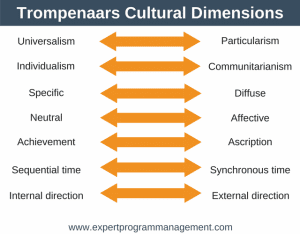If you’ve ever worked with colleagues based in a different continent, or even just a neighboring country then you will have likely encountered cultural differences. Even if you haven’t encountered cultural differences yet, it is increasingly likely that you will have to at some point as business becomes ever more international in nature. Did you know that a model already exists to help us understand cultural differences?
It’s called Hofstede’s Cultural Dimensions, and using it can help us get off to a good start with new colleagues, new clients, or new projects and programs. Rather than being a strict set of rules the model is more of a aid to help you think about how to interact and approach different cultures.
There are five dimensions to the model:
1. Power Distance Index (PDI)
This dimension measures the distribution of wealth and power within a culture. What this dimension is aiming to show is the extent to which people within a culture submit to authority. The higher the PDI the more hierarchical the culture, and the lower the figure the more likely people at all levels are to work together.
2. Individualism and Collectivism (IDV)
This dimension concerns the relationship been a typical individual and larger social groups. The higher this score the more a culture encourages individuality and uniqueness. The lower this score the more a culture encourages conformity and interdependence.
Individualistic cultures are more likely to have people feeling responsible for taking care of themselves, people are responsible for their own identity and achievement, hiring is based on merit, and people believe everyone has a right to a private life.
Collective cultures are more likely to value loyalty to the group, including extended family and company. People value the achievement of the team because they value belonging, and because of this a persons “personal life” is often invaded by the demands of the group or organization.
3. Masculinity and Femininity (MAS)
In this dimension masculinity (a higher score) is seen as placing value on the acquisition of wealth, personal ambition, and discrete gender roles. Femininity is seen as valuing sexual equality, caring behaviors, and less strict gender roles.
Another way of viewing this is that in masculine societies men are supposed to be tough, assertive, and breed winners, whereas women are supposed to be more tender and concerned with quality of life. Conversely, in feminine societies roles intersect and overlap. Both sexes are expected to be tender and concerned with quality of life.
4. Uncertainty Avoidance Factor (UAI)
This dimension measures how a culture copes and handles uncertainty, that is, how the culture handles ambiguity. The higher the score less well the culture is at handling ambiguity.
5. Long-Term Orientation (LTO)
Hofstede’s original work contained just 4 dimensions. However, a later study noted that these 4 dimensions didn’t fully reflect the Asian perspective. As a result of this, the fifth dimension, long-term orientation was added.
This dimension measures how much value a culture places on long-term rewards. A low score signals short-term orientation and measures how much value is placed on past and present.
Traits of long-term orientation include valuing persistence, thrift, and also that leisure time isn’t that important. Conversely, short-term orientation includes valuing immediate gratification and results, spend now, and that leisure time is important.
Cultural Dimensions Example
As an example, let’s compare the cultural differences between China and the US. Each country’s score for each of the five factors is shown in the table below. Note that the range for each score is 0 to 120.
| Country | Power Distance Index | Individualism | Masculinity | Uncertainty Avoidance | Long-Term Orientation |
|
|
|||||
| China | 80 | 20 | 66 | 40 | 118 |
| USA | 40 | 91 | 62 | 46 | 29 |
The interesting values to note in this example are those that differ significantly, namely PDI, IDV, and LTO.
Compared to the US, we can see that in China it is less likely that people at all levels are working together and that the workplace is more likely to be hierarchical. We can see that in china the achievement of the team and belonging matter much more than they do in the US. We can also see that Chinese culture is much more long-term orientated than that of the US.
If your a program manager or any other type of leader, then understanding these values can give you insight as to how you should interact with your team or colleagues. For example, incentivizing your team with short term rewards is less valued in China so how about appealing to people’s sense of belonging and arranging activities to strengthen the team instead? Or even making team performance more important than personal performance when determining how bonuses will be calculated?
Summary
The five dimensions of culture help us understand the makup and preferences of different cultures. By understanding how these indicators differ from those of our own cluture we can obtain valuable clues to ensure we get off to a good start when working with new and diverse team members, new clients, and new projects and programs.
To get the most out of Hofstede’s Cultural Dimensions you need to experiment, engage with your team, and see what works best for you.
I’ve included a list of all the different indicator values below (taken from Clearly Cultural, here).
| Country | Power Distance Index | Individualism | Masculinity | Uncertainty Avoidance | Long-Term Orientation |
|
|
|||||
| Malaysia | 104 | 26 | 50 | 36 | |
| Guatemala | 95 | 6 | 37 | 101 | |
| Panama | 95 | 11 | 44 | 86 | |
| Philippines | 94 | 32 | 64 | 44 | 19 |
| Mexico | 81 | 30 | 69 | 82 | |
| Venezuela | 81 | 12 | 73 | 76 | |
| China | 80 | 20 | 66 | 40 | 118 |
| Egypt | 80 | 38 | 52 | 68 | |
| Iraq | 80 | 38 | 52 | 68 | |
| Kuwait | 80 | 38 | 52 | 68 | |
| Lebanon | 80 | 38 | 52 | 68 | |
| Libya | 80 | 38 | 52 | 68 | |
| Saudi Arabia | 80 | 38 | 52 | 68 | |
| United Arab Emirates | 80 | 38 | 52 | 68 | |
| Ecuador | 78 | 8 | 63 | 67 | |
| Indonesia | 78 | 14 | 46 | 48 | |
| Ghana | 77 | 20 | 46 | 54 | 16 |
| India | 77 | 48 | 56 | 40 | 61 |
| Nigeria | 77 | 20 | 46 | 54 | 16 |
| Sierra Leone | 77 | 20 | 46 | 54 | 16 |
| Singapore | 74 | 20 | 48 | 8 | 48 |
| Brazil | 69 | 38 | 49 | 76 | 65 |
| France | 68 | 71 | 43 | 86 | |
| Hong Kong | 68 | 25 | 57 | 29 | 96 |
| Poland | 68 | 60 | 64 | 93 | |
| Colombia | 67 | 13 | 64 | 80 | |
| El Salvador | 66 | 19 | 40 | 94 | |
| Turkey | 66 | 37 | 45 | 85 | |
| Belgium | 65 | 75 | 54 | 94 | |
| Ethiopia | 64 | 27 | 41 | 52 | 25 |
| Kenya | 64 | 27 | 41 | 52 | 25 |
| Peru | 64 | 16 | 42 | 87 | |
| Tanzania | 64 | 27 | 41 | 52 | 25 |
| Thailand | 64 | 20 | 34 | 64 | 56 |
| Zambia | 64 | 27 | 41 | 52 | 25 |
| Chile | 63 | 23 | 28 | 86 | |
| Portugal | 63 | 27 | 31 | 104 | |
| Uruguay | 61 | 36 | 38 | 100 | |
| Greece | 60 | 35 | 57 | 112 | |
| South Korea | 60 | 18 | 39 | 85 | 75 |
| Iran | 58 | 41 | 43 | 59 | |
| Taiwan | 58 | 17 | 45 | 69 | 87 |
| Czech Republic | 57 | 58 | 57 | 74 | |
| Spain | 57 | 51 | 42 | 86 | |
| Pakistan | 55 | 14 | 50 | 70 | |
| Japan | 54 | 46 | 95 | 92 | 80 |
| Italy | 50 | 76 | 70 | 75 | |
| Argentina | 49 | 46 | 56 | 86 | |
| South Africa | 49 | 65 | 63 | 49 | |
| Hungary | 46 | 55 | 88 | 82 | |
| Jamaica | 45 | 39 | 68 | 13 | |
| United States | 40 | 91 | 62 | 46 | 29 |
| Netherlands | 38 | 80 | 14 | 53 | 44 |
| Australia | 36 | 90 | 61 | 51 | 31 |
| Costa Rica | 35 | 15 | 21 | 86 | |
| Germany | 35 | 67 | 66 | 65 | 31 |
| United Kingdom | 35 | 89 | 66 | 35 | 25 |
| Switzerland | 34 | 68 | 70 | 58 | |
| Finland | 33 | 63 | 26 | 59 | |
| Norway | 31 | 69 | 8 | 50 | 20 |
| Sweden | 31 | 71 | 5 | 29 | 33 |
| Ireland | 28 | 70 | 68 | 35 | |
| New Zealand | 22 | 79 | 58 | 49 | 30 |
| Denmark | 18 | 74 | 16 | 23 | |
| Israel | 13 | 54 | 47 | 81 | |
| Austria | 11 | 55 | 79 | 70 | |








